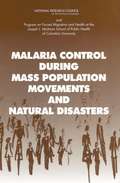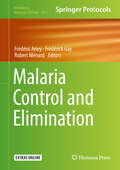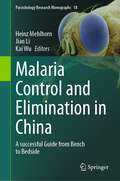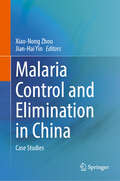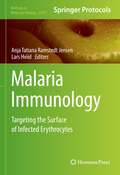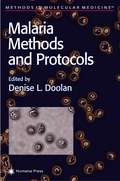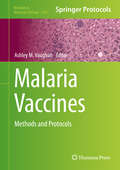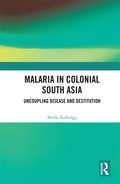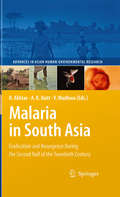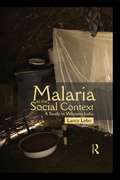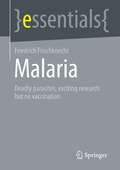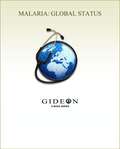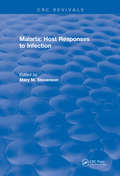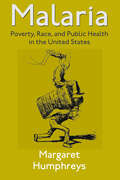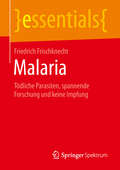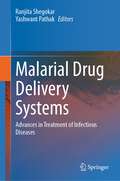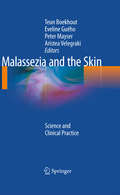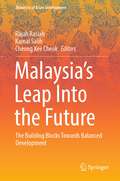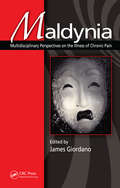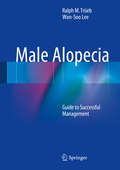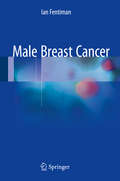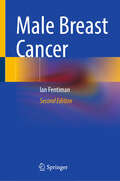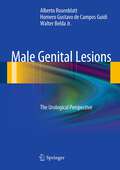- Table View
- List View
Malaria Control During Mass Population Movements And Natural Disasters
by Peter B. BlolandAdmittedly, the world and the nature of forced migration have changed a great deal during the last two decades. The relevance of data accumulated during that time period can now be called into question. The roundtable and the Program on Forced Migration and Health at the Mailman School of Public Health of Columbia University have commissioned a series of epidemiological reviews on priority public health problems for forced migrants that will update the state of knowledge. "Malaria Control During Mass Population Movements and Natural Disasters--the first in the series--provides a basic overview of the state of knowledge of epidemiology of malaria and public health interventions and practices for controlling the disease in situations involving forced migration and conflict.
Malaria Control and Elimination (Methods in Molecular Biology #2013)
by Robert Ménard Frédéric Ariey Frédérick GayThis detailed book serves to provide a global overview of the goals, rationale, and scientific basis for malaria control and elimination, as well as tools, methods, and strategies to that end. Opening with a section on malaria epidemiology, the volume continues by covering tools that are critical to malaria management, anti-malarial drugs and resistance to these drugs, vaccination approaches against malaria, vector control, as well as some perspective on the future of the fight against this devastating disease. Written for the highly successful Method in Molecular Biology series, chapters in this collection feature the kind of practical, hands-on advice that leads to better results in the field. Authoritative and important, Malaria Control and Elimination is a valuable reference for all those involved in malaria control and elimination worldwide, from students to health practitioners and field researchers seeking to make eradication a reality wherever possible.
Malaria Control and Elimination in China: A successful Guide from Bench to Bedside (Parasitology Research Monographs #18)
by Jian Li Heinz Mehlhorn Kai WuThis volume provides cutting-edge research from malaria parasitology and records the success story of disease control in China. The country, which was certified malaria-free by the World Health Organization in 2021, looks back on 70 years of effort and fruitful combat history.Expert authors supply insights from Plasmodium morphology to the clinical picture of malaria, molecular and immunodiagnosis, as well as current treatment and resistance issues, making this book a valuable blueprint for further success stories. The present work makes a significant contribution to the Sustainable Development Goal (SDG) 3, Good Health and Well-Being, with the aim to end malaria epidemics by 2030. Practical details of malaria elimination tools and strategies are completed by chapters on artificial intelligence in diagnosis and also traditional Chinese medicines for therapy. All researchers involved in malaria control and elimination around the globe will benefit from the knowledge presented, including students, scientists, policy makers at various levels, and professionals in healthcare and antiparasitic drug discovery.
Malaria Control and Elimination in China: Case Studies
by Xiao-Nong Zhou Jian-Hai YinThis book intends to provide the lessons and efforts on malaria control and elimination practices in several classical endemic areas with different transmission characteristics. The book collects seven cases on malaria surveillance and response based on the 1-3-7 approach in Jiangsu Province, the border malaria control and elimination in Yunnan Province, the fight against malaria among forest goers in the mountainous areas in Hainan island, the focal mass drug administration for Plasmodium vivax control in Anhui Province, the vector control response to malaria re-emergence in Henan Province, and the review of discovery history of artemisinin, as well as the international promotion of ACTs. The book is likely to be of interest to professionals/practitioners and policy makers in government or industry in the field of malaria control and prevention, and related researchers, especially in the malaria transmission areas targeting malaria elimination.
Malaria Immunology: Targeting the Surface of Infected Erythrocytes (Methods in Molecular Biology #2470)
by Anja Tatiana Ramstedt Jensen Lars HviidThis volume covers a broad range of methods, technologies, and protocols on malaria. Chapters detail research on collecting parasites in the field, single molecule-level analyses of adhesive interactions, and focused studies aiming at disrupting the devastating disease. Written in the format of the highly successful Methods in Molecular Biology series, each chapter includes an introduction to the topic, lists necessary materials and reagents, includes tips on troubleshooting and known pitfalls, and step-by-step, readily reproducible protocols. Authoritative and cutting-edge, Malaria Immunology: Targeting the Surface of Infected Erythrocytes aims to be a useful and practical guide to researches to help further their study in this field. Chapter Analysis of var gene transcription pattern using DBLα-tags [Chapter 14] is available open access under a Creative Commons Attribution 4.0 International License via link.springer.com.
Malaria Methods and Protocols
by Denise L. DoolanInternationally respected scientists and clinicians describe in step-by-step detail their most useful conventional and cutting-edge techniques for the study of malaria. Areas covered include clinical and laboratory diagnosis and typing, animal models, molecular biology, immunology, cell biology, vaccinology, laboratory models, and field applications. Each readily reproducible protocol has been tested, standardized, and optimized for experimental success, and includes many laboratory notes on troubleshooting, avoiding pitfalls, and interpreting results. Several of the most widely used methods are described here in detail for the first time or have been thoroughly updated since their original publication (e.g., in vitro culture of Plasmodium parasites and in vitro growth inhibition assay).
Malaria Vaccines
by Ashley VaughanThis volume focuses on malaria vaccinology, and introduces researchers to a complete overview of the protocols and tools used by molecular and cellular malariologists. The chapters within this book talk about interventions concerning all aspects of life cycle progression--measuring antibody responses to blood stage parasite survival, the T Cell responses engendered by attenuated sporozoite vaccinations, and the unique effect on transmission of antibodies that target the mosquito stage of the life cycle. Additionally, methods concerning the ability to generate targeted gene deletions and replacements in the genome of Plasmodium parasites convey how Plasmodium parasite phenotypes can be created to precise specifications. More recently, the potential power of humanized mouse models of disease progression have been demonstrated and are also discussed in the book. Written in the highly successful Methods in Molecular Biology series format, chapters include introductions to their respective topics, lists of the necessary materials and reagents, step-by-step, readily reproducible laboratory protocols, and tips on troubleshooting and avoiding known pitfalls. Cutting-edge and thorough, Malaria Vaccines: Methods and Protocols is a useful and unique resource for any aspiring malaria vaccinologists because of the volume's exquisitely detailed methodologies that are not typically found in published literature.
Malaria in Colonial South Asia: Uncoupling Disease and Destitution
by Sheila ZurbriggThis book highlights the role of acute hunger in malaria lethality in colonial South Asia and investigates how this understanding came to be lost in modern medical, epidemic, and historiographic thought. Using the case studies of colonial Punjab, Sri Lanka, and Bengal, it traces the loss of fundamental concepts and language of hunger in the inter-war period with the reductive application of the new specialisms of nutritional science and immunology, and a parallel loss of the distinction between infection (transmission) and morbid disease. The study locates the final demise of the ‘Human Factor’ (hunger) in malaria history within pre- and early post-WW2 international health institutions – the International Health Division of the Rockefeller Foundation and the nascent WHO’s Expert Committee on Malaria. It examines the implications of this epistemic shift for interpreting South Asian health history, and reclaims a broader understanding of common endemic infection (endemiology) as a prime driver, in the context of subsistence precarity, of epidemic mortality history and demographic change. This book will be useful to scholars and researchers of public health, social medicine and social epidemiology, imperial history, epidemic and demographic history, history of medicine, medical sociology, and sociology.
Malaria in South Asia
by Rais Akhtar Ashok K. Dutt Vandana WadhwaThis highly topical book provides an in-depth account of the South Asian experience with the deadly disease that has held this region hostage for millennia. The book touches specifically on the resurgence of malaria experienced in the second half of the twentieth century, which occurred just a few years after malaria was thought to have been virtually eradicated from the region. The progress of this reappearance across space and time, as well as its causes and consequences, are discussed. The book also covers past, present and future ways to curb, control and ultimately, conquer malaria. As malaria continues to ravage the developing world, even in today's 'age of science', this is a particularly relevant book, especially as most studies analyze the problem in Africa, the continent that bears the brunt of this disease. Here, the authors call attention to challenges in South Asia, home to an immense at-risk population. The chapters in this book use a range of conceptual frameworks, quantitative analyses and descriptive aapproaches, finding that malaria is not just a complex disease driven by highly adaptive agents and vectors thriving in particular ecologies, but also a social concern deeply related to the region's cultural traditions, financial and developmental shortfalls, and inexorably related to political will. The book comprehensively deals with all aspects of the malaria situation in South Asia, and is invaluable to upper level students as well as emerging and established scholars in the fields of medical geography and epidemiology, Asian studies and development studies.
Malaria in the Social Context: A Study in Western India
by Lancy LoboThis book underscores how, apart from bacteriological factors, human behavioural characteristics as well as the socio-cultural factors that affect people’s lives contribute to the risk for and prevention of infection, with particular focus on malaria. It argues that the implementation of malaria-control measures can be successful only if it considers the human response to malaria and control measures. Any new tool which is introduced in a particular area — be it a new vaccine, a new drug combination, the promotion of impregnated bed nets, spraying of insecticides, or improved home management — will be effective and sustainable only if it is adapted to needs of the local population, i.e., if it makes sense to them. This volume also studies traditional knowledge systems with respect to health and malaria, arguing that local knowledge about infection is the result of an amalgamation of the biomedical and the traditional. By attempting to identify how traditional and biomedical elements interrelate in local illness concepts, it hopes to assist health interventionists in providing efficacious health education and awareness among people.
Malaria: Deadly parasites, exciting research and no vaccination (essentials)
by Friedrich FrischknechtFriedrich Frischknecht gives an insight into malaria and the biological complexity of the parasites that trigger it. The author takes the reader on a journey from the historical discovery of the pathogen to the modern methods of vaccine development. He explains how genetic manipulations help to understand the parasite and to develop novel vaccination approaches. He explains the difficulties that need to be overcome to eradicate malaria.The author: Prof. Dr. Friedrich Frischknecht studied biochemistry at the Freie Universität Berlin and did his PhD on smallpox viruses at the European Molecular Biology Laboratory (EMBL) in Heidelberg. After a research stay at the Institut Pasteur in Paris, he has been head of a research group at the University Hospital in Heidelberg since 2005 and is interested in the molecular basis of the movement of malaria parasites.
Malaria: Global Status 2010 edition
by Dr Stephen Berger Gideon InformaticsMalaria: Global Status is one in a series of GIDEON ebooks which summarize the status of individual infectious diseases, in every country of the world. Data are based on the GIDEON database (www.gideononline.com) which relies on standard text books, peer-review journals, Health Ministry reports and ProMED, supplemented by an ongoing search of the medical literature. Chapters are arranged alphabetically, by country name. Each section is divided into five subsections. 1. Descriptive epidemiology 2. Summary of clinical features 3. Global status of the disease 4. Status of the disease in a specific country 5. References
Malaria: Host Responses to Infection (CRC Press Revivals)
by Mary M. StevensonThe purpose of this book is to analyze and determine how a host responds to a blood stage malaria infection. It focuses on strategies for anti-malarial vaccination, genetic control of host resistance to malaria, and the contribution of the host genetic background to resistance or susceptibility to malaria. This book is an important reference work for anyone who studies the field of microbiology, immunology, or parasitology.
Malaria: Molecular and Clinical Aspects
by Mats Wahlgren Peter PerlmannMalaria causes more death and disease than any other parasitic pathogen known today. This multiauthored text covers the important areas of malaria research, particularly focusing on those sectors which are of clinical importance for the understanding of the disease, the parasite, and its vector. The chapter authors are all leading experts withi
Malaria: Poverty, Race, and Public Health in the United States
by Margaret HumphreysThis is the story of a war against a disease that we can never win but must continue to fight.In Malaria: Poverty, Race, and Public Health in the United States, Margaret Humphreys presents the first book-length account of the parasitic, insect-borne disease that has infected millions and influenced settlement patterns, economic development, and the quality of life at every level of American society, especially in the south.Humphreys approaches malaria from three perspectives: the parasite's biological history, the medical response to it, and the patient's experience of the disease. It addresses numerous questions including how the parasite thrives and eventually becomes vulnerable, how professionals came to know about the parasite and learned how to fight them, and how people view the disease and came to the point where they could understand and support the struggle against it. In addition Malaria: Poverty, Race, and Public Health in the United States argues that malaria control was central to the evolution of local and federal intervention in public health, and demonstrates the complex interaction between poverty, race, and geography in determining the fate of malaria.
Malaria: Poverty, Race, and Public Health in the United States
by Margaret HumphreysFrom a prominent medical historian, “a fascinating story of the spread of malaria through the USA following its introduction in the seventeenth century” (Nature Medicine).Margaret Humphreys presents the first book-length account of the parasitic, insect-borne disease that has infected millions and influenced settlement patterns, economic development, and the quality of life at every level of American society, especially in the south and during its peak in the nineteenth century.Humphreys approaches malaria from three perspectives: the parasite’s biological history, the medical response to it, and the patient’s experience of the disease. It addresses numerous questions including how the parasite thrives and eventually becomes vulnerable, how professionals came to know about the parasite and learned how to fight it, and how people view the disease and came to the point where they could understand and support the struggle against it.In addition Malaria: Poverty, Race, and Public Health in the United States argues that malaria control was central to the evolution of local and federal intervention in public health, and demonstrates the complex interaction between poverty, race, and geography in determining the fate of malaria.“A masterpiece . . . recommended reading for anyone involved in or interested in health care.”?Southern Medical Journal“The lack of jargon makes the book accessible to a wide audience.”?Journal of the History of Medicine
Malaria: Tödliche Parasiten, spannende Forschung und keine Impfung (essentials)
by Friedrich FrischknechtFriedrich Frischknecht gibt einen Einblick in die Malaria und die biologische Komplexität der sie auslösenden Parasiten. Der Autor nimmt den Leser mit auf eine Reise von der historischen Entdeckung der Erreger zu den modernen Methoden der Impfstoffentwicklung. Dabei erläutert er, wie genetische Manipulationen helfen, den Parasiten zu verstehen und neuartige Impfansätze zu entwickeln. Er erläutert die Schwierigkeiten, die zur Ausrottung von Malaria zu überwinden sind.Der Autor: Prof. Dr. Friedrich Frischknecht hat nach dem Studium der Biochemie an der Freien Universität Berlin am Europäischen Molekularbiologischen Laboratorium (EMBL) in Heidelberg über Pockenviren promoviert. Nach einem Forschungsaufenthalt am Institut Pasteur in Paris leitet er seit 2005 eine Forschungsgruppe am Universitätsklinikum in Heidelberg und beschäftigt sich mit den molekularen Grundlagen der Bewegung von Malariaparasiten.
Malarial Drug Delivery Systems: Advances in Treatment of Infectious Diseases
by Yashwant Pathak Ranjita ShegokarThis book targets new advances in areas of treatment and drug delivery sciences for Malaria. This is the only published book which compiles the complete road map of malarial drug delivery systems along with an overview on the pathology, current state of malaria across the globe, new clinical trials, emerging drugs and evolving novel drug delivery platforms. A wide variety of novel micro-and nano-formulations using promising technologies are being explored to deliver the malarial drug via different administration routes. This book addresses the gap between new approaches and old treatment modalities and how the former is superior in pharmacological performance when tested in in-vitro and in-vivo. Audience from wide range group like from researchers to regulatory bodies can benefit from the compiled information to find out patient needs and addresses a much-needed update to the existing malaria drug delivery research.
Malassezia and the Skin
by Peter Mayser Aristea Velegraki Teun Boekhout Eveline Guého-KellermannThis book, written by a group of acknowledged experts, is the first comprehensive overview on the very unusual yeasts of the genus Malassezia. All relevant aspects of the genus and its 13 species are covered in detail within 11 chapters. The first chapter reviews the long and controversial history of the genus, while the second describes all mycological characteristics of the different species, including media and techniques adapted to their isolation, description, and maintenance. Subsequent chapters methodically address issues such as the effect of Malassezia yeasts on human and animal health, and the current therapeutic approaches for Malassezia-induced or -exacerbated diseases. The last chapter provides a summary of data to be presented on a website that will be regularly updated, thus incorporating latest findings. Microbiologists, mycologists, dermatologists, and veterinarians will find this book a useful and up-to-date source of information.
Malaysia’s Leap Into the Future: The Building Blocks Towards Balanced Development (Dynamics of Asian Development)
by Rajah Rasiah Kamal Salih Cheong Kee CheokThis book presents the future development of Malaysia. It puts together building blocks to achieve a better future. These blocks are poverty and income inequality, population, demography and urbanization, growth and technological progress, education, human capital and skills, finance, labor, the environment, and health care. It examines the reasons for the decline in the agricultural sector with an emphasis on food security. It discusses Malaysia’s economic growth and structural change compared to some of the Northeast East Asian and Southeast Asian countries. It explains the projections of population and demographic change and its bearing on government policies. It evaluates the country’s education sector and discusses the strategies to improve its role in the country further. It argues for replacing ethnic-based approaches with a needs-based system for the future direction to build a plural Malaysia. This insightful book is of interest across several fields, including demography, economic development, and urbanization.
Maldynia: Multidisciplinary Perspectives on the Illness of Chronic Pain
by James GiordanoWhether initiated by injury or disease, induced and sustained by changes in the nervous system, or manifested by society and culture, chronic pain can change one's first-person experience of the body and the world, and ultimately impacts cognitions, emotions, and behavior. Many fine medical books address the causes and management of chronic intract
Male Alopecia
by Ralph M. Trüeb Won-Soo LeeThis monograph provides specialists and primary care physicians who are interested in hair with the practical know-how needed to achieve successful management of male alopecia. Guidance is first provided on the examination of hair loss in men, covering such aspects as clinical examination, the role of trichoscopy and the trichogram, laboratory work-up and scalp biopsy. Diagnosis and treatment are then described in depth for a diverse range of conditions involving alopecia. Expert opinion is combined with the results of evidence-based medicine to provide the best current advice, highlighting the synergistic action of combination regimens and adjuvant treatments and explaining the concept of multitargeted treatment. All aspects of follow-up are covered, including compliance issues and expectation management. The role of hair care and cosmetics is also considered, with identification of potential adverse effects as well as benefits.
Male Breast Cancer
by Ian FentimanMale Breast Cancer provides an up-to-date review of the risk factors and genetics influencing the development of this rare disease. This volume presents clinical features and recent advances in histopathology and molecular profiling are analyzed, providing a valuable aid to clinicians in tailoring treatment to both the patient and the tumour. Readers will find important insights into the most effective strategies for making or negating a diagnosis of MBC. Within this timely volume, consideration is also given to the psychological needs of men with breast cancer alongside a discussion of the most effective support methods. The surgical management of the disease is examined, together with algorithms for local and systemic therapy. Owing to the problem of late diagnosis in MBC, many men have advanced or disseminated disease at diagnosis and, as such, the evidence-based management of these cases is reviewed. Male Breast Cancer concludes with a discussion on determining prognosis and the likely future developments in MBC with a focus on improved diagnosis and survival. Male Breast Cancer will be of interest to breast surgeons, oncologists, breast radiologists, breast histopathologists and breast care nurses worldwide.
Male Breast Cancer
by Ian FentimanThis second edition of the book is fully updated and refreshed to include all recent important evidence (2017-2024). Aimed at a postgraduate audience, it has a structured format with a synopsis at the end of each chapter. This book provides an up-to-date review of the risk factors and genetics influencing the development of this rare disease. This volume presents clinical features and recent advances in histopathology and molecular profiling are analysed, providing a valuable aid to clinicians in tailoring treatment to both the patient and the tumour. Readers will find important insights into the most effective strategies for making or negating a diagnosis of MBC. Within this timely volume, consideration is also given to the psychological needs of men with breast cancer alongside a discussion of the most effective support methods. The surgical management of the disease is examined, together with algorithms for local and systemic therapy. Owing to the problem of late diagnosis in MBC, many men have advanced or disseminated disease at diagnosis and, as such, the evidence-based management of these cases is reviewed. Male Breast Cancer concludes with a discussion on determining prognosis and the likely future developments in MBC with a focus on improved diagnosis and survival. Male Breast Cancer will be of interest to breast surgeons, oncologists, breast radiologists, breast histopathologists and breast care nurses worldwide. The book is a useful reference source for the totality of relevant information on male breast cancer.
Male Genital Lesions
by Homero Gustavo Campos Guidi Alberto Rosenblatt Walter Belda Jr.With the increased incidence of HPV-related genital diseases, including premalignant and malignant penile lesions, urologists and practitioners in general face numerous difficult challenges when attempting to diagnose genital lesions correctly. Despite the importance of genital lesions in the male, there are few books on the subject in the English medical literature. Male Genital Lesions will serve as an invaluable aid to the differential diagnosis of sexually transmitted infections, benign dermatological genital lesions, and premalignant and malignant genital disorders. More than 700 high-definition full-color figures of common disease presentations are included, with legends describing real clinical cases. The illustrations are supported by a concise, up-to-date text that describes etiology, pathology, clinical manifestations, laboratory tests, and treatment options for the individual diseases.
